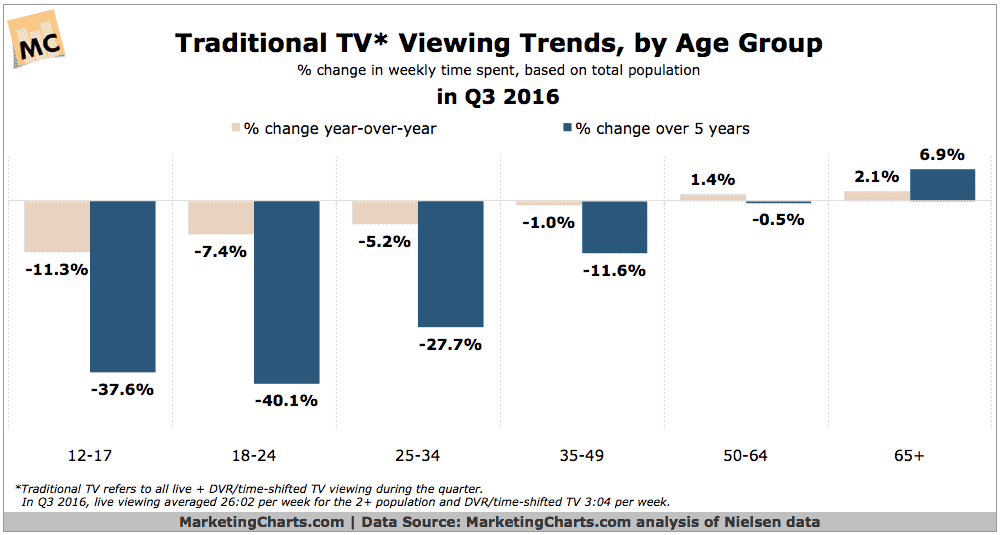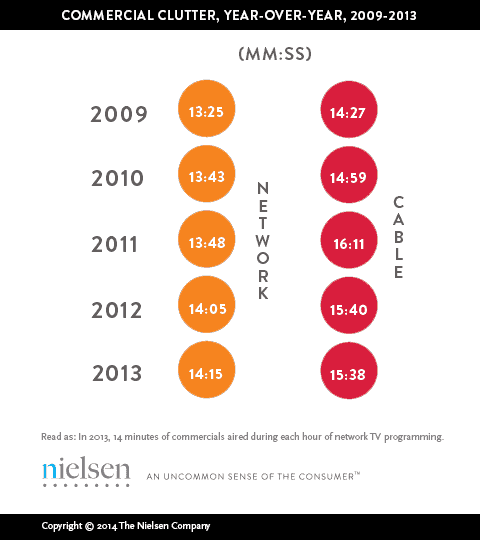The way people consume their media has changed drastically. No longer are consumers set by schedules or glued to their televisions for chunks of time. Beyond that, many are “cutting the cord” and switching to various forms of over-the-top (OTT) media. This has created a window of opportunity for advertisers, lowering the barriers of entry for running an effective media campaign.
Disruption in Cable Television Viewership
It is safe to say that there has been a disruption in the traditional media world that started years ago. First, time-shifted viewing habits became the norm, mostly caused by the advent of DVR recordings. Then, viewing habits changed again with various forms of OTT media and connected TV devices. The latter is most apparent in younger generations, where traditional TV viewing time has dropped by 40 percent over the course of the last five years, according to data recently released by Nielson. [1]
At first glance, it might seem that people are watching less video media and migrating their time to unrelated activities. This is not the case. Demand for video has never been greater with one-third of all online activity spent watching video. Google claims, “YouTube reaches more 18+ year-olds during prime-time TV hours than any cable TV network.” [2]

Regardless of the source of their video, it has become clear that people are no longer willing to make the time to watch their media on a set schedule.
Over-The-Top Media and Connected TV
Over-the-top refers to any media that is delivered over the internet as opposed to traditional cable or satellite television methods. The most common examples would include streaming services like Netflix and Hulu, or devices like Roku.
An indication of the times, Netflix recently posted its best ever quarter for subscription growth, showing no signs of slowing down in the near future. In 2016, OTT media providers, such as Netflix, recorded total revenues of $1 billion. According to ABI Research, this figure is set to increase 600 percent to $7 billion by 2021. [3]
Connected TVs (or smart TVs) are televisions that have internet and Web 2.0 capabilities. This gives users the ability to download and run applications from various OTT media services. It is almost impossible to find a television retailing today that doesn’t have these capabilities.
Between the introduction of these non-traditional methods of viewing television and changing social habits of younger generations, there’s rapid change in the industry. The year of 2016 marked the first time that more than half of Americans watched some form of digital TV either as an alternative or in conjunction with traditional TV.
Advertising on Connected TV Creates Opportunity for Small Businesses
While these changes have led to many headaches for big cable companies, it has also opened doors for smaller businesses.
Think about it: In the past, after incurring the costs of production for a 15- or 30-second commercial, the additional costs of broadcasting the commercial just wasn’t feasible for the little guy. The average primetime spot on broadcast television cost $75,000 in 2013. [4]
Meanwhile, the average commercial time for cable television has continued to increase and therefore diluted the viewers’ attention. Commercial time as a portion of total programming runtime has never been higher. So even if small companies could come up with the dough, it wasn’t a worthy investment because their target audience wasn’t paying attention.
Enter OTT. One benefit of many OTT media providers is the fact that commercial breaks are limited and therefore will demand more attention from viewers.

OTT media and smart TV devices have also changed the way ads are served. Serving ads to various streaming applications and devices completely cuts out cable companies. These ads are also served directly via the internet. This allows for lower costs, as well as more detailed targeting capabilities.
Perhaps the most appealing aspect is that these campaigns require no minimum budget and a much lower initial budget (than traditional TV campaigns and media buys) in order to be effective. Video ads served on connected TV devices can be bought either on spot market or through private contracts, but the pricing model will almost always be on a cost per thousand impressions (CPM). Perhaps the biggest benefit is being able to bid on a per user basis.
Targeting a customer base through television ads has never been easier: determine a target audience, set up a corresponding campaign and place a winning bid.
To the small business owner, this means you can have the prestige of video advertising on television sets while not having to cough up large sums of money. The precise targeting capabilities and even measured results provide a whole world of opportunity that otherwise wouldn’t be available.
If you are a small business owner who thought about running a television media campaign but couldn’t afford it, the opportunity presented by connected TV and other OTT media services should not be ignored.
Points Group has an in-house video production department, as well as a full-service digital marketing department with access to premium inventory across many different connected TV devices and over-the-top media services. If you are interested in running a highly effective media campaign, contact our specialists for more information.


